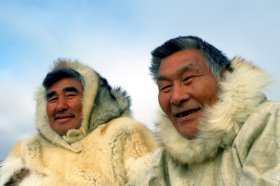
In 1964, the Canadian pianist Glenn Gould took the Muskeg Express, a train that travels north more than 1,000 kilometres from Winnipeg to Churchill, in the upper reaches of Manitoba. At breakfast, he struck up a conversation with a surveyor Wally McLean and was impressed to learn about his ‘craft’ which was ‘to find in the most minute measurement, a suggestion of the infinite’.
Gould subsequently invited Wally to be the narrator for a radio documentary called the Idea of North. The one hour program included five voices in a contrapuntal structure that interwove varying strains of romanticism, cynicism and reflection. The nurse Marianne Schroeder describes her initial fears about the monotony of the North and how she began to identify with its innocent beauty. Frank Vallee criticises attempts at ‘northmanship’ where one seeks to outdo the other in experiences of remoteness.
Gould was notorious for eschewing the concert hall and retiring to the privacy of the recording studio. Accordingly, what interested Gould in the North was the experience of solitude. He identified with austere Nordic composers such as Sibelius, Bach, and Schoenberg.
Out of this isolation emerges a nation. Fellow Canadian composer R. Murrary Schafer stated that ‘All the energy of the world radiates from the Magnetic North Pole.’ One of the prophets of Canada’s north was Vilhjalmur Stefansson, an Arctic explorer of Icelandic descent. In 1922 he wrote ‘There is no northern boundary beyond which productive enterprise cannot go until North meets North on the opposite shore of the Arctic Ocean.’ This North is Canada’s frontier.
For Jim Lotz, Canada is founded on those parts of the North American continent that few others wanted. The North thus becomes a secret appreciated only by Canadians. Kevin McMahon describes the Arctic as Canada’s own mythological territory, defining nationhood in the same way that the Wild West defined the USA and the open seas defined England.
There have been attempts to broaden this idea of North beyond Canada. In Peter Davidson’s Idea of North, he notes the visit to St Petersburg in 2003 by the Canadian Governor General Adrienne Clarkson. She proposed to the Russians a ‘new humanism of the North’ shared to reverse the southern perspective that sees the far North only as a region to be exploited for its natural resources.
Canadian identity is grounded in the North. In her Canada and the Idea of North, Sherrill Grace quotes Henry Beissel’s Cantos North (1982) that the north ‘discovered us / fell upon our vanity / with tomahawks of ice’. Grace describes the Canadian idea of North as a habitus— a deep-seated phenomenological orientation that informs the Canadian sense of self.
It’s an interesting challenge with which to begin a journey to the idea of South. To what extent might the idea of South that we are exploring here be a version of the Canadian idea of North? Both might entail concern for a region that needs protecting from the rest of the world. A sense of inferiority becomes a noble mission.

And on the other hand, is Canada south? If you take colonisation as the common element linking countries of the South, then Canada shares much in common with settler nations like Australia and South Africa. A recent book by Joan Fairweather identifies the common cause shared between Canada and South Africa in the land claims of their Indigenous peoples.
So why couldn’t Canada be South? This question brings into relief the physical sense of South, evident in the weather, the skies and the nature. It points to a problem that an idea of South must resolve: how to reconcile the historical trajectory of the South with its physical reality. Canada puts that question on our agenda.
It also raises the possibility that the division between North and South may not be binary. If South is defined in opposition to a dominant North, then North eventually becomes South when its power wanes with distance in whatever direction. This is the idea of South as periphery. And if for Europeans the South is the realm of sunshine, then in countries like Australia, the northern state of Queensland is more south than Victoria below it.
These complexities prompt a dynamic concept of space. But how elastic can an idea of South be before it loses its meaning? Where does South end? What is the limit of South?
References
Listen to the start of Glenn Gould’s Idea of North
- Peter Davidson The Idea of North London: Reaktion, 2005
- Joan G. Fairweather A Common Hunger: Land Rights In Canada And South Africa Calgary: University of Calgary Press, 2006
- Sherrill Grace Canada and the Idea of North McGill-Queen’s Press – MQUP, 2002
- Jim Lotz Northern Realities: The Future of Northern Development in Canada Toronto: New Press, 1970